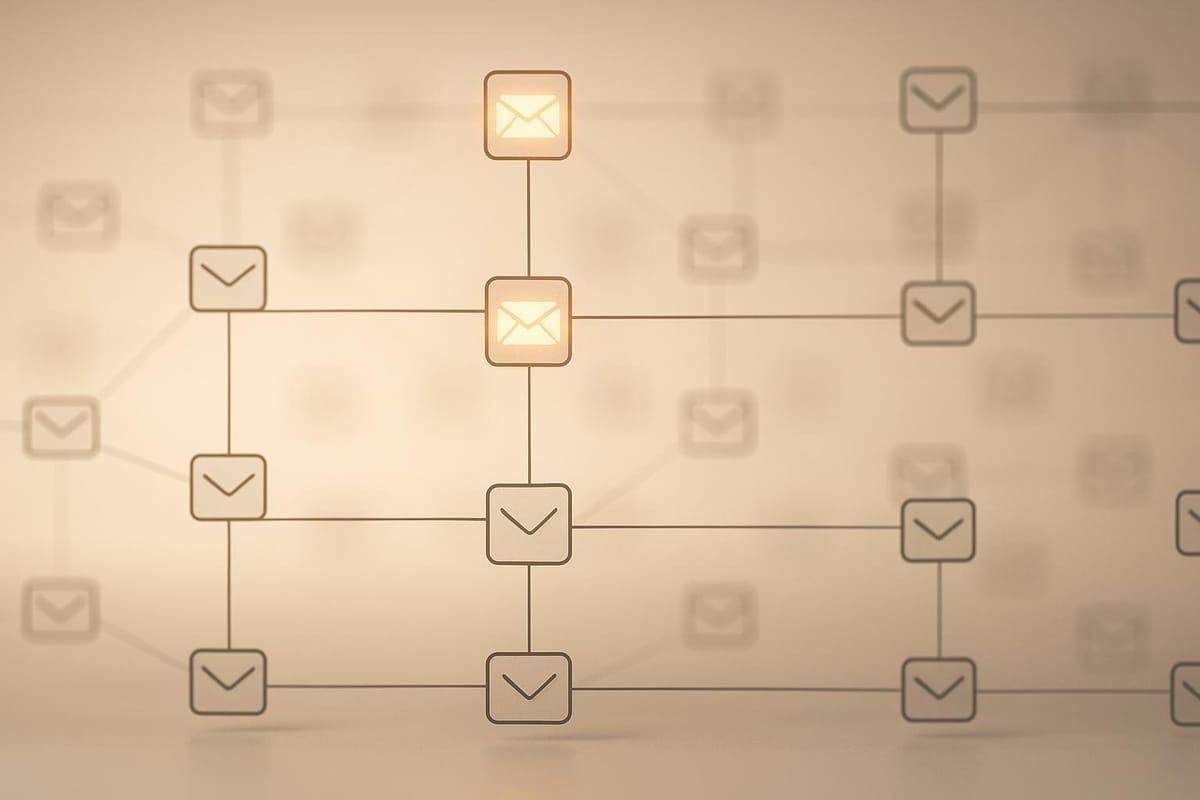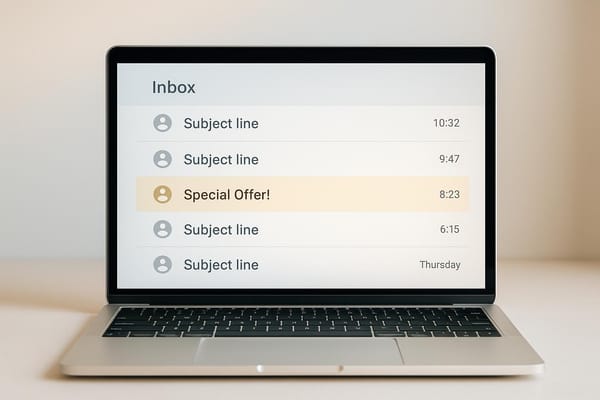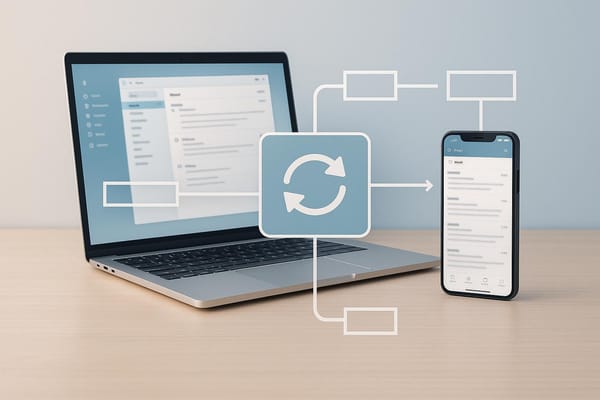How Email Volume Affects Domain Reputation
Learn how email volume affects your domain reputation and discover best practices for maintaining deliverability and engagement.

Your domain reputation directly impacts whether your emails land in inboxes or get flagged as spam. If you send emails erratically - sudden spikes or drops in volume - email providers like Gmail and Yahoo may see this as suspicious behavior. This can lead to poor deliverability, spam filtering, or even blacklisting. Here's what you need to know:
- What It Is: Domain reputation is like a credit score for your email-sending domain. High engagement (opens, clicks) improves it, while spam complaints or low engagement hurt it.
- Why Volume Matters: Consistent email volume builds trust. Sudden changes, like jumping from 1,000 to 100,000 emails in a week, can harm your reputation.
- Risks: Poor domain reputation means lower open rates, wasted marketing dollars, and potential blacklisting.
- How to Protect It:
- Gradually increase email volume (e.g., 10–20% weekly).
- Focus on high-engagement recipients first.
- Monitor metrics like open rates and spam complaints (keep complaints under 0.1%).
- Use tools like SPF, DKIM, and DMARC for authentication.
The Ultimate Guide to Understanding and Improve Domain Reputation
How Email Volume Impacts Domain Reputation
The number of emails you send can have a direct effect on your domain's reputation and email deliverability. The key? Keep your sending habits steady, predictable, and gradually increase over time. Let’s explore how to manage your email volume to maintain a solid reputation.
Why Consistent Sending Patterns Are Important
Email providers like Gmail, Yahoo, and Outlook look for consistent sending patterns from legitimate senders. When your email volume remains steady, it signals that your domain is reliable and engaged in genuine communication. On the flip side, unpredictable patterns - like sudden bursts of emails or erratic sending - can raise red flags. Providers may suspect spam activity or compromised accounts, which could harm your deliverability.
The Risks of Spikes and Drops in Email Volume
Big swings in your email volume can spell trouble. For example, jumping from a few hundred emails to tens of thousands overnight can trigger spam filters. When that happens, your emails might get blocked, throttled, or sent straight to spam folders.
But it’s not just spikes you need to worry about - sudden drops in volume can also signal issues. Abrupt declines might point to poor list management or inconsistent campaign practices, both of which can damage your domain’s reputation. If a volume spike leads to higher complaints or lower engagement, you risk crossing thresholds that could severely impact your deliverability.
How to Determine the Right Email Volume
Once you’ve avoided dramatic shifts, it’s time to fine-tune your email volume to match your audience’s engagement levels. Start small, especially if you’re working with a new domain. For example, sending 5–10 emails daily and gradually increasing over 30–60 days is a safer approach. Keep an eye on key metrics like opens, clicks, and replies. If sending 1,000 emails results in strong engagement, you might be ready to scale up. However, if complaints rise or engagement drops, increasing volume too quickly could backfire.
Also, tailor your volume to your audience’s capacity. Sending 50,000 emails to a list of just 10,000 subscribers in a short period can overwhelm recipients and lead to complaints. Instead, focus on sending fewer, more relevant emails to engaged subscribers. By segmenting your list and targeting those most likely to interact positively, you create stronger engagement signals. Over time, this approach helps protect and even improve your domain’s reputation.
Best Practices for Scaling Email Campaigns Safely
Scaling email campaigns effectively means growing your efforts in a way that protects your sender reputation. This requires consistent patterns, high engagement rates, and building trust with email providers.
How to Warm Up Your Domain Gradually
A gradual domain warm-up is the first step toward scaling safely. Start small - send about 5–10 emails per day to your most engaged recipients. These are the people who regularly open, click, and reply to your emails, signaling legitimacy to email providers.
Increase your sending volume by 10–20% each week over a 30–60 day period. For instance, if you start with 10 emails per day in week one, aim for 12 emails in week two, and 14–15 in week three. This gradual increase avoids sudden spikes that could hurt your reputation.
If you want to speed up this process, consider using pre-warmed mailboxes. These accounts already have a sending history, helping you skip the slow start. Services like Icemail.ai offer pre-warmed mailboxes starting at $5 per month, allowing you to scale faster without sacrificing deliverability.
To maximize early success, focus on sending emails to recipients who have recently engaged with your content. This generates positive signals for email providers. Keep a close eye on these initial campaigns and adjust your sending volume based on engagement.
Tracking Engagement Metrics
Engagement metrics are your window into the health of your email campaigns and help you determine how quickly you can scale. Key metrics to monitor include open rates, click rates, reply rates, and complaint rates. Mailbox providers generally expect complaint rates to stay below 0.1%, with anything over 0.3% putting your deliverability at serious risk.
For example, if you send 1,000 emails in a day, getting more than one complaint could raise red flags, and receiving three or more complaints could significantly harm your reputation. On the flip side, high engagement and low complaint rates indicate that your emails are valued by recipients.
Check these metrics daily. If open rates drop or complaints rise, scale back your volume and re-engage your most active segments. Using segmentation and personalization can also help tailor your content to your audience, boosting engagement and reducing complaints.
Complying with U.S. Anti-Spam Laws
Alongside monitoring engagement, compliance with U.S. anti-spam laws is a must to safeguard your domain reputation. The CAN-SPAM Act requires clear sender information, a valid physical address, and an easy-to-find unsubscribe option. Additionally, subject lines should always be accurate and free of misleading language to maintain trust with recipients.
Properly configuring SPF, DKIM, and DMARC is essential for verifying your identity with email providers. Tools like Icemail.ai can automate these setups, saving you time and ensuring compliance.
"Icemail.ai has transformed how I manage my email infrastructure. The automated setup for Google Workspace accounts, including DKIM, SPF, and DMARC configuration, saved me hours of work."
- Suprava Sabat, @AcquisitionX
Regularly cleaning your email lists is another crucial step. Removing inactive or invalid email addresses reduces the risk of triggering spam filters and helps maintain a strong sender reputation. By sticking to these practices, you can scale your campaigns while keeping your emails in recipients' inboxes for the long haul.
How Icemail.ai Simplifies Scalable Email Outreach

Scaling email campaigns while protecting your domain reputation can be tricky, but having the right tools makes all the difference. Icemail.ai takes on the heavy lifting, automating tasks that typically take days or even weeks. Here's how it delivers speed, high deliverability, and cost efficiency.
Quick and Easy Email Infrastructure Setup
Setting up email infrastructure can be a tedious process, but Icemail.ai streamlines it. You can configure bulk mailboxes, domains, and DNS records in just 10 minutes. Within 30 minutes, your emails are fully ready to go, thanks to automated authentication setups like DKIM, DMARC, and SPF.
The platform simplifies everything, from connecting your existing domains to setting up new ones with its AI Domain Finder. By automating these processes, it reduces the risk of manual errors that could harm your deliverability or domain reputation.
Designed for High Deliverability
Icemail.ai is built to keep your emails landing in inboxes, even as you scale up. With a 99.2% inbox delivery rate, it tackles common challenges that come with high-volume outreach.
One standout feature is the use of mailboxes with pre-established sending histories. This means you can skip the lengthy domain warm-up process and start scaling right away without compromising deliverability.
Additionally, all mailboxes are configured using US-IP Google and Microsoft accounts. The platform includes volume management tools to ensure consistent sending patterns, avoiding sudden spikes that might trigger spam filters or harm your domain reputation.
Why Choose Icemail.ai?
Icemail.ai’s technical advantages translate directly into more effective and scalable email campaigns. While traditional email setup can take hours or even days, Icemail.ai’s 10-minute deployment gives businesses a real edge.
The platform also offers a flexible pay-as-you-use pricing model, eliminating the hassle of subscriptions or locked plans. For example:
- Google Admin mailboxes: $2.50/month
- Microsoft mailboxes: $3.00/month
- IMAP/SMTP mailboxes: $0.50/month
This structure ensures your costs grow only as your campaigns expand, making it an efficient choice for businesses of all sizes.
Users consistently praise Icemail.ai for its fast setup and intuitive design. It’s a perfect fit for teams without dedicated IT resources. Agencies and businesses managing multiple clients will especially appreciate features like dedicated workspace accounts and bulk management tools. With the ability to configure hundreds of mailboxes at once and make bulk updates to names and profile pictures, Icemail.ai makes scaling email outreach easier than ever.
Monitoring and Fixing Domain Reputation Issues
Keeping a close eye on your domain reputation is just as important as following best practices for scaling campaigns. A drop in reputation can act as an early warning system, signaling the need for immediate action to prevent further setbacks.
Warning Signs of Reputation Damage
Domain reputation issues rarely appear out of nowhere. Instead, they tend to reveal themselves through warning signs that get worse if left unchecked. One of the first red flags is a rise in bounce rates, which often points to Internet Service Provider (ISP) rejections.
Another key indicator is spam folder placement. If your emails suddenly start ending up in spam, it’s a sign that mailbox providers are flagging your messages as unwanted. This can happen due to inconsistent sending patterns or a drop in recipient engagement.
Pay close attention to spam complaint rates as well. Both Google and Yahoo expect bulk senders to maintain complaint rates below 0.1%. Crossing the 0.3% threshold can lead to severe penalties, including deliverability issues. Even a small increase in complaints suggests that recipients may not find your emails relevant.
The most serious sign of reputation damage is blacklisting. If your domain ends up on DNS-based blacklists or real-time blackhole lists, many email providers will block your messages altogether. This often happens after sudden spikes in email volume or poor engagement trends.
Steps to Fix Reputation Damage
If you notice signs of reputation damage, act quickly to contain the situation. Start by halting large-scale email sends. Continuing to send emails while your reputation is compromised can make the problem worse.
Next, evaluate your recent sending patterns. Look for irregularities - such as sudden increases in email volume, drops in engagement, or issues with your email list quality. Cleaning your list is critical: remove invalid, inactive, or unengaged contacts to reduce bounce rates and improve overall engagement.
Verify your email authentication records, including SPF, DKIM, and DMARC. Ensuring these are correctly configured helps demonstrate to ISPs that your emails are legitimate.
To rebuild trust, gradually increase your email volume. Start small, sending just 5–10 emails per day, and slowly ramp up over 30–60 days. Focus on sending to your most engaged recipients first, as their positive interactions will help restore your reputation.
Improving recipient engagement is essential. ISPs pay attention to metrics like open rates, click-through rates, and reply rates. To boost these, segment your email list, personalize your messages, and ensure each email delivers meaningful value to the recipient.
Once you’ve implemented these steps, use monitoring tools to track your progress and ensure your reputation is on the mend.
Tools for Real-Time Monitoring
Real-time monitoring tools are invaluable for keeping tabs on your domain reputation after making corrections. Platforms like Icemail.ai provide a range of features, including real-time tracking of domain health, sending limits, and reputation metrics. Automated alerts notify you of potential issues, allowing for quick responses. Icemail.ai also simplifies authentication setup and uses pre-warmed mailboxes to reduce common risks.
Key metrics to monitor include bounce rates, spam complaints, open rates, click-through rates, and blacklist status. For example, if your bounce rate jumps above 5% or your spam complaint rate exceeds 0.1%, it’s time to investigate and take corrective action.
Regular monitoring also helps you track the effects of scaling your email campaigns. As you increase your sending volume, keep a close eye on engagement metrics. A decline in these numbers may indicate that you’re scaling too quickly and need to adjust your approach. By staying vigilant, you can maintain a healthy domain reputation and ensure long-term success.
Conclusion: Scaling Email Campaigns While Protecting Domain Reputation
Successfully scaling email campaigns while keeping your domain reputation intact is all about balance - growth must go hand in hand with deliverability best practices. The connection is clear: sudden spikes or drops in email volume can set off spam filters and harm your reputation. On the other hand, steady, gradual increases build trust with mailbox providers.
For instance, companies that leapt from sending 1,000 emails a week to 100,000 experienced inbox placement rates plummet to below 20%. Meanwhile, those that took the time to follow gradual warm-up protocols and focused on engaged recipients kept their inbox placement rates above 90%.
Consistency in sending patterns is critical during growth phases. Start small - 5 to 10 emails a day - and gradually increase over 30 to 60 days, keeping weekly growth to a manageable 10–20%. Also, managing spam complaint rates is non-negotiable. Gmail and Yahoo, for example, require complaint rates to stay below 0.1%, as rates exceeding 0.3% can result in serious deliverability problems.
Automation tools can make this process much easier. Platforms like Icemail.ai are designed to simplify scaling efforts while safeguarding your domain reputation. They offer automated setups for DKIM, DMARC, and SPF, pre-warmed mailboxes starting at $5/month, and an infrastructure fine-tuned for achieving a 99.2% inbox delivery rate.
In the long run, a strong domain reputation translates into better inbox placement, higher engagement, improved ROI, and lasting sender credibility. By scaling carefully, monitoring recipient engagement, and using the right tools, businesses can grow their email campaigns without risking their reputation.
FAQs
What can I do to monitor and improve my domain reputation if my email deliverability drops?
If your email deliverability has taken a hit, it’s crucial to act quickly to protect your domain reputation. Start by examining your email-sending habits. Make sure you're focusing on active, engaged recipients and steering clear of sudden increases in email volume, which can trigger warnings from email providers.
Looking for a hands-off way to manage this? Icemail.ai might be the answer. This platform simplifies email infrastructure management with tools for bulk mailbox purchases and domain configuration. Plus, it automates the setup of DKIM, DMARC, and SPF - key protocols for ensuring your emails land in inboxes, not spam folders. With Icemail, you can scale your email campaigns effectively while maintaining a strong sender reputation, all without wasting time on tedious setups.
How can I safely increase my email volume without hurting my domain reputation?
To scale your email campaigns safely while keeping your domain reputation intact, start by optimizing your email setup for strong deliverability. Increase your sending volume gradually to avoid being flagged by spam filters, and make it a priority to send emails only to verified and actively engaged recipients.
A service like Icemail.ai can make this process much easier. They provide reliable email infrastructure with features like bulk mailbox purchases, automated domain setup, and advanced tools for managing deliverability, including DKIM, DMARC, and SPF configuration. With their quick setup process and positive user feedback, they’re a solid option for handling scalable email campaigns with ease.
How does Icemail.ai help scale email campaigns while protecting domain reputation and ensuring high deliverability?
Icemail.ai simplifies the challenge of scaling email campaigns by offering an automated email infrastructure that prioritizes deliverability. With built-in features like automated DKIM, DMARC, and SPF configuration, the platform ensures your emails are authenticated correctly, reducing the chances of them landing in spam folders.
The platform also makes setting up mailboxes a breeze, supporting services like Google Workspace and Microsoft mailboxes to help you ramp up campaigns quickly. With its advanced tools and dependable reputation management, Icemail.ai stands out as a top option for safeguarding your domain reputation while expanding your outreach efforts effectively.





